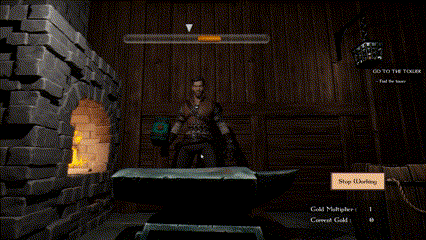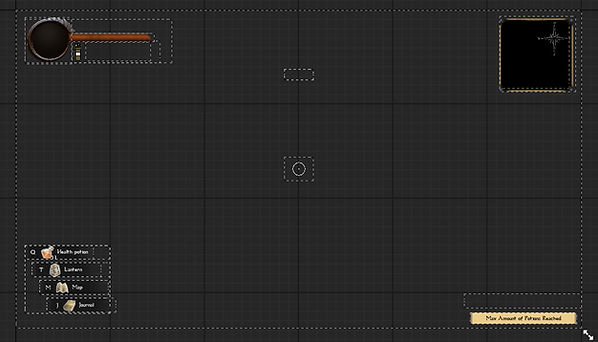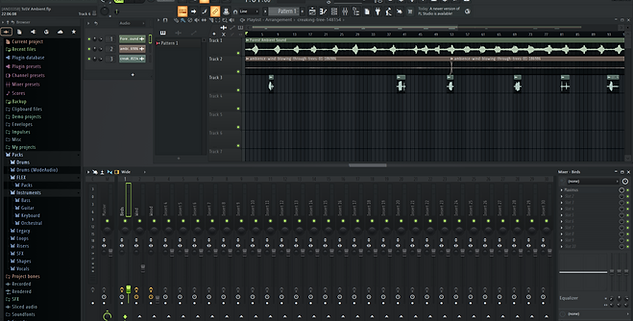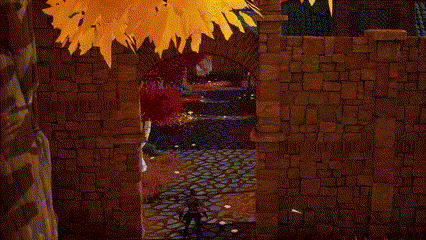
Game and Level Designer

Tales of The Sundered Vale
Third person / Action Adventure
Introduction
Tales of the sundered vale is a Third Person / Action - Adventure game.
It was a Students Project made in 15 Weeks.
The player returns to their village, only to find it in ruins. the village has been almost entirely destroyed by a devastating fire.
As the player assist the remaining villagers, explore dangerous dungeons, and battle fearsome monsters, they face numerous choices that will determine the village’s fate.
Ultimately, the protagonist must confront and defeat the force that caused the village's destruction, restoring peace to their homeland.
Details
-
Project Made in 3 Months
-
Unreal Engine 5
-
Team of 5 people
-
Create a Game Design Document
-
Game Design
-
User Interface
-
Sound Effects
-
Level Sequence
Pre-Production
As one of the Game Designer on this project, my first step was to do reference gathering, as it streamlines the development workflow and serves as the design foundation.
For this project, we drew heavy inspiration from Fable 2 and Kingdoms of Amalur: Reckoning,
particularly for their whimsical fantasy aesthetics and fast-paced combat systems. These elements became the core pillars of our design focus.


Documentation
I began by creating a Game Design Document (GDD) using Canvas,
outlining the core vision and structure of the project.
This document served as a living reference for the design team, ensuring consistency and clarity throughout development.
To establish a strong User Experience (UX) and User Interface (UI) direction, I compiled UI reference materials, analyzing layout compositions, readability, and player accessibility from various Action RPGs from the 2000s.
I then defined the project’s design pillars, focusing on key aspects such as core game mechanics, progression systems, and the primary game loop. This helped shape the overall player experience and ensured that every gameplay element contributed to the intended moment-to-moment engagement.
For task management and workflow organization, We utilized Trello to create a structured task-tracking system, enabling efficient task dispersion among the team. This allowed us to monitor milestones, assign responsibilities, and maintain a clear development pipeline from prototyping to implementation.
Scripting
I've developed a suite of tools that streamline the level design workflow, allowing designers to easily place and implement assets, gameplay elements, and environmental details into the map. These tools are designed for accessibility, requiring minimal technical expertise while maximizing efficiency in world-building.
Region Name Volume : Volume with a Character Overlap Adding Name of the Region with fading Animation and Music Transition
Tutorial Prompt Volume : Volume with a Character Overlap Adding Text with fading Animation and a Sound Effect
Camera Look At : Box Colison with a component Character Overlap and a Target as BPI
Cinematic Trigger Volume : Box Volume triggerd by the player who play a level sequence
Collectible ''Parent'' : Blueprint made to inherit properties from the Parent to use in a Child Blueprint. When Player is Near a prompt appears, when pressed E a VFX plays with a SFX and the Collectible Dissapear.
Collectible ''Child'' : The Child inherit all the properties from the Parent.
Mini-Game
As the Game Designer, I aimed to implement a mini-game inspired by the Blacksmith job from Fable 2. Using a Widget Blueprint, I began prototyping how this would function. The goal of the mini-game is to provide players with a gold farming mechanic. With the Gold earned, The player could either Upgrades his weapons for smoother dungeon clearing or with enough Ressources Repair the Village.
Prototype :
Arrow animations Moving from Left to Right constantly
Progress Bar Shrinking to the center
Click the button to Gain Money
Alpha Version :
Arrow animations Moving from Left to Right constantly
Progress Bar Shrinking to the center
Click the button to Gain Money
Player Animation Playing when click in the Green Zone
Player Animation Playing when click Outside of the Green Zone
Finale :
New Visual to fit with the Game esthethics and UI
Arrow animations Moving from Left to Right constantly
Progress Bar Shrinking to the center
Click on the screen to forge
Player Animation Playing when click in the Green Zone
Player Animation Playing when click Outside of the Green Zone
Must be in the Green Zone to Gain Money and add +1 to the Multiplier
If outside of the Green Zone it counts has you failed and reset the Gold Multiplier



Item Inventory Page : Designed to efficiently display detailed item data, including stats, descriptions, rarity, and usage, ensuring players can easily manage their collectibles.
Navigation Bar : Built for intuitive UX, offering a streamlined and responsive layout for seamless menu transitions and quick access to key features.
Quest Log : Tracks active and completed quests, providing clear objectives, narrative context, and waypoint guidance to keep players immersed and on track.
Task System : A hub for challenges and side objectives, rewarding players for completing assignments and fostering player engagement with progression incentives.
Forge Shop : A dedicated interface for weapon upgrades, allowing players to enhance their arsenal, modify stats, and unlock new combat abilities.
Alchemist Shop : Enables potion upgrades, increasing capacity, potency, and player max health, ensuring balanced resource management for survival and strategy.
User Interface
I was also tasked with designing the User Interface (UI), starting with a prototype of the Heads-Up Display (HUD) and Inventory Menu using Inkscape.
For the Inventory Menu, I drew inspiration from The Legend of Zelda: The Wind Waker, crafting an intuitive and visually engaging layout that balances function and aesthetics.
For the HUD, I referenced The Witcher 3: Wild Hunt, focusing on clarity, minimalism, and easy readability during gameplay.
Both designs prioritized player accessibility, ensuring seamless navigation and a clean, user-friendly experience.


Sound Effect
For this project i was also responsable for all the Sound Effects and the Music.
In total i made around 120 sound effects for this project alone.
Every SFX were made using the software FL Studio 25.
A lot of Copyright free sounds were also used and modified to simplify the production of the Project.


Sampling
I've Started by importing Samples and putting them in FL Studio.
I Listen to the Sample until i find the Moment that i Like and cut it out.
I play with the Pitch, Volume, Lenght until i like how the sample sound
I repeate the process for each of the Sample
Then I put the Sample in a channel and start the Mixing Process

Mixing
When it comes to Mixing on Fl Studio
I often start by adding the Plugins Maximus in the Master Mixer
and proceed to add a compressor on the channel with the sample i wish to mix.
Things could changes depending of what sound i am Mixing has some sounds are meant to be agressive and loud has other are meant to be more subbtle
Music
For the Music the process was a bit diffrent.
Most of the Music used in the Game were not made by me but were Copyright free Medieval Fantasy music that i have altered by Changing the pitch, reduce or increase the speed, but i have worked on two music that were used in the final product.
They were made to be used in loop and to be added along the Ambient sound track.



Integration
Once all the sound effects (SFX) were finalized, I integrated them into the game by implementing audio cues and ensuring proper synchronization with gameplay elements.
Assigned appropriate sound effects to player and enemy animations using Anim Notifies to trigger audio at precise moments, such as attack swings, footsteps, and impact.
Implemented sound effects for interactive objects and collectibles, ensuring that each item produced distinct and immersive audio feedback upon interaction or pickup.
Integrated UI sound design by adding audio feedback to the Main Menu and all interactable UI elements, including button clicks, hover sounds.
Designed the audio environment by incorporating background music and ambient soundscapes across all game maps, using Trigger Volumes to dynamically adjust audio based on player location and game events.
This approach ensured an immersive and responsive audio experience throughout the game.

Level Sequence
I was responsible for designing and implementing in-game cinematics that served multiple purposes, such as reinforcing quest objectives, enhancing narrative depth, and improving overall player immersion.
Using Unreal Engine's Level Sequence tool,
I created a total of 10 real-time cinematics, carefully choreographing character animations, camera movements, VFX, and lighting to match the intended tone and storytelling beats.
In addition to directing these sequences, I also handled all aspects of audio design. This included composing and integrating ambient soundscapes, crafting dynamic sound effects, and ensuring seamless audio transitions.
Cinematics
Certain Level Sequences are triggered by my Cinematic Trigger Volume, which acts as a predefined collision-based activation zone for scripted cutscenes or in-game cinematics.
Other sequences are dynamically triggered through the Quest System, where specific Quest States update in response to player actions, progressing objectives and executing corresponding Blueprint Scripting logic to initiate cinematic events.
This ensures that key narrative moments or environmental changes are seamlessly integrated into the player's journey.
My work helped establish an immersive audiovisual experience that supported the gameplay flow and narrative cohesion.
These cinematics were strategically designed to improve affordance by guiding player attention toward key objectives, revealing backgates, highlighting landmarks for navigation, and reinforcing world-building elements.
By leveraging principles of visual composition, camera language, and player psychology, I ensured that each cinematic not only conveyed crucial story elements but also served as an intuitive gameplay aid.





